T-14 Armata
The T-14 Armata (Russian: Т-14 «Армата»; industrial designation "Ob'yekt 148", Russian: Объект 148) is a next-generation Russian main battle tank based on the Armata Universal Combat Platform—the first series-produced next-generation tank. The Russian Army initially planned to acquire 2,300 T-14s between 2015 and 2020.[16][17][18][19] Production and fiscal shortfalls delayed this to 2025,[20] and then to the cancellation of the main production run.[21] The test batch of 100 is to be delivered and deployed to the 2nd Guards Tamanskaya Motor Rifle Division, with delivery expected in 2020 or later; tanks will be transferred only after the completion of all state tests.[22][23][24]
| T-14 Armata[1] | |
|---|---|
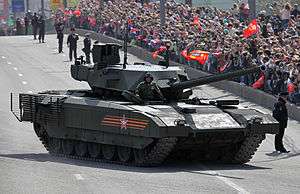 Russian Army T-14 Armata during the 2015 Moscow Victory Day Parade | |
| Type | Main battle tank |
| Place of origin | Russia |
| Service history | |
| Used by | Russian Ground Forces |
| Production history | |
| Designer | Ural Design Bureau of Transport Machine-Building, Uralvagonzavod[2] |
| Manufacturer | Uralvagonzavod[2] |
| Unit cost | $3.7 million[3][4] |
| Produced | 2015–present |
| No. built | 20+ (100 planned)[5][6][7][8][9] |
| Specifications | |
| Mass | 55 tonnes[10] |
| Length | 8.7 m (29 ft)[11] |
| Width | 3.5 m (11 ft) |
| Height | 3.3 m (11 ft) |
| Crew | 3[2] |
| Armor | 44S-sv-Sh[2][12]
Glacis: 900 mm vs APFSDS and 1400 mm vs HEAT. Internal armored capsule with more than 900 mm RHA equivalent[13] Malachit dual ERA (4th generation ERA) can reduce penetration of APFSDS and HEAT rounds by at least 50% |
Main armament | 2A82-1M 125 mm (4.92 in) smoothbore cannon with 45 rounds (32 of them in the autoloader).[14] Future version may use the smoothbore 2A83 152 mm tank gun. |
Secondary armament | 12.7 mm (0.50 in) Kord machine gun (6P49), 7.62 mm (0.30 in) PKTM machine gun (6P7К) |
| Engine | Diesel 1,500 hp[15]–2,000 hp[15] |
| Power/weight | 31hp/t |
| Transmission | 12-speed automatic gearbox |
Operational range | min[15] 500 kilometres (310 mi) |
| Maximum speed | 80 km/h (50 mph)–90 km/h (56 mph) (estimated)[15] |
History
The tank was first displayed in public during rehearsals for the 2015 Moscow Victory Day Parade. During the 2015 rehearsals, one of the tanks suddenly stopped moving, and after attempts to tow it failed, it moved away under its own power after about 15 minutes.[25][26]
At least seven T-14 Armata tanks appeared in the 2015 and 2016 Moscow Victory Day parade, five in 2017 and 2018. Four were anticipated in promotional materials in advance of the 2019 parade.[27]
Procurement
The Russian Federation was expecting to order 2,300 T-14 main battle tanks for delivery by 2020. In 2015, Russian media had announced that around 20 tanks had been delivered for testing, without naming a source. However, in 2016 the Russian Defence Ministry announced that it had signed a contract for a “test batch” of 100 T-14 tanks to be delivered by 2020, with the full project extended until 2025.[28]
In July 2018, Deputy Prime Minister for Defence and Space Industry Yury Borisov said there is currently no need to mass-produce the Armata when its older predecessors, namely the latest variants of the T-72, remain "effective against American, German and French counterparts”, saying, “Why flood our military with Armatas, the T-72s are in great demand on the market(s).”[21][29] Instead, a modernization program of the T-72s, T-80s and T-90s in-service will take precedence.[30] In August 2018, at the ARMY2018 Forum outside Moscow, the Russian Ministry of Defense signed a contract for the purchase of 32 T-14s tanks and 100 T-15 infantry fighting vehicles, with delivery to be finished by 2021.[31] In February 2019 it was announced that the first 12 tanks would be delivered by the end of that year.[24] In August 2019, the Russian Military-Industrial Courier reported that out of a contractually agreed 132 Armata-platform vehicles over three years to 2021 (including T-14 tanks, and also T-15 IFVs and T-16 BREM ARVs (ru:Т-16 (БРЭМ)), assuming production of 44 vehicles a year, only 16 would be delivered by the end of 2019. This implied a shortfall of at least 28 vehicles that year. Uralvagonzavod had apparently suffered severe personnel turnover, reportedly linked to financial abuses.[32][33] By November 2019 the delivery forecast slipped to "late 2019 or early 2020."[34]
In mid January 2020 the head of Rostec said no Armata-platform vehicles including T-14 tanks had been delivered, and in February the CEO of Uralvagonzavod only said that Armata-platform armour (not necessarily T-14 tanks) would start shipping to begin operation evaluation in 2020, with the full contract of 132 Armata-platform vehicles completed by 2022.[35][36] Furthermore, also in February 2020 it became evident that the set of requirements for the intended engine of the tank were not met by the construction bureau and the project of development of the engine would be closed in first quarter of 2020, further delaying the introduction of the tank for an unspecified time.[37] In August 2020, the Industry and Trade minister told journalists that the production of 132 Armata-platform tanks and fighting vehicles had begun after the resolution of problems with engines and night-vision equipment, and they would be issued to the armed forces in 2021.[38]
Design
The Armata was designed over the course of five years, and features a number of innovative characteristics, including an unmanned turret. The crew of three is seated in an armoured capsule in the front of the hull,[39] which will also include a toilet for the crew.[40]
Armament
The main armament of the T-14 is the 2A82-1M 125 mm (4.92 in) smoothbore cannon,[41] a replacement for the 2A46 125 mm gun of previous Russian and Soviet tanks. According to Russian sources, its muzzle energy is greater than that of the German Leopard 2's Rheinmetall 120 mm gun, which is considered one of the world's best cannons, as well as its main competitor. The 2A82-1M gun is 15–20% more accurate than 2A46, while also boasting a 70% increase in accuracy while moving compared to the older 125 mm Soviet cannons. Features include an absence of a fume extractor (due to the unmanned turret), a fire rate of 10–12 rpm (rounds per minute), left side casing ejection port for the 125 mm gun[42] and a maximum effective-penetration range of 8 km with ATGMs. The 2A82-1M 125 mm cannon can fire a wide range of ammunition, including armour-piercing fin-stabilized discarding sabot (APFSDS) projectiles, guided missiles, high-explosive anti-tank (HEAT-FS) shells, air-burst HE-Frag shells[43] and other types of rounds.[44] The Vacuum-1 APFSDS round, developed for the 2A82-1M gun, has a penetrator that is 900 mm long,[2] and is said to be capable of penetrating 1 m of RHA equivalent at a distance of 2 km.[45][46] The new controlled-detonation Telnik HE-Frag shell is available and has entered service.[47][48] The gun is capable of firing guided missiles like the 9M119M1 Invar-M which has an effective range of 100 m to 5 km, and can engage low-flying air targets such as helicopters,[49] with a new 3UBK21 Sprinter ATGM with an effective range up to 12 km developed specifically for it.[15][50] 3UBK25 active homing ATGM is currently under development.[51] It should also be noted that the Russian military has plans to upgrade to a massive 152 mm gun, which, according to a top ranking Russian official, will be able to pierce through one meter of steel.[52]
The secondary armament consists of a 12.7×108mm Kord (GRAU index 6P49) machine gun with 300 rounds (not observed during the 2015 parade) and a 7.62×54mmR Pecheneg PKP (GRAU Index: 6P41) or a PKTM (6P7К) machine gun with 1,000 rounds.[2][49][53] All guns are remotely controlled.[49] In addition, another 1,000 rounds can be stored separately.[39] A 12.7 mm machine gun is installed above the turret roof-mounted commander's sight, which avoids visual obstructions, while the turret front has a peculiar slit that is speculated to be intended for the coaxial 7.62 mm machinegun. The tank's turret might be fitted with a Shipunov 2A42 30 mm cannon to deal with various targets, including low-flying aerial targets, such as attack planes and helicopters.[44]
In the future, the T-14 may use the 2A83 152 mm gun instead of its current 2A82-1M 125 mm gun.[49][54][55][56] The cannon, which was first developed in 2000 for the T-95 prototype,[2] has a high-speed APFSDS shell with a 1,980 m/s muzzle velocity, only dropping to 1,900 m/s at 2 km.[57][58][59] However, Russian engineers have so far kept the 125 mm-size gun, assessing that improvements in ammunition are enough to increase effectiveness, while concluding that a larger bore weapon would offer few practical advantages.[60]
The T-14 can also use anti-aircraft missiles.[2][61] A 30 mm anti-aircraft gun may be installed in the near future.[62]
Mobility
The T-14 is powered by a ChTZ 12N360 (A-85-3A) diesel engine[2][63] delivering up to 1,500 hp.[2] The engine's theoretical maximum power, not normally used,[64] is 2,000 hp, at the cost of radically decreasing its service life, projected min[65] 2,000 hours at nominal 1,500 hp,[2] comparable to other modern tank engines, and up to 10,000 hours at moderated 1,200 hp.[63] The engine is electronically controlled.[66] Operational range is over 500 km.[67]
The T-14 has a 12-speed automatic gearbox, with a top speed of 80–90 kilometres per hour (50–56 mph) and a range of 500 kilometres (310 mi).[2] At least one expert speculated that the transmission might be an electronically controlled mechanical gearbox with external reverse and demultiplier gears, giving the tank equal forward and reverse gear ranges.[68] Other sources suggest a partly or fully hydrostatic transmission.[69] Uniquely for a Soviet/Russian design, the transmission is joined with the engine into a single unit that can be swapped out in the field in just under 30 minutes.
Unlike previous Russian and Soviet designs, such as the T-90/80/72/64, the T-14 has seven 700 mm road wheels per side, based on the T-80 variant.[69] It has the ability to adjust the suspension of at least two first roadwheels, and, probably, the last ones.[70] In the 2015 Moscow Victory Day Parade rehearsal video, a T-14 Armata is shown retracting one of its frontal first wheels during turns. This, along with published design blueprints,[70] suggest at least a partial hydraulic suspension system based on the adjustable lever arm shock absorbers that now double as suspension actuators.[70] This may have been done to improve the pivoting ability of the tank, as an active suspension system improves the target lock time by a factor of 2.2, and reduces the timeframe between target detection and reaction by 31%, all due to the resulting smoother ride.[2][70]
Much thought was given to the tank's strategic mobility. Its moderate mass of 48 tons allows it to be easily transported by rail or trailer, which conserves its engine and transmission's service life, and to cross the majority of bridges in Russia. Two T-14s with their crews and all attending equipment can be easily airlifted by the heavy An-124 transport plane. However, the most numerous Russian strategic airlifter, the Il-76, is only able to lift one T-14 and its needed equipment in its newest, PS-90-equipped variant.
Protection
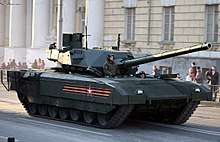
The T-14's crew of three is protected by an internal armored capsule[2] with more than 900 mm RHA equivalent, Both the chassis and the turret are equipped with the Malachit dual-explosive reactive armour (ERA) system on the front, sides and the top.[46] The tank uses an integrated, computerized control system which monitors the state and functions of all tank modules. In battle, the software can analyze threats and then either suggest or automatically take actions to eliminate them, while without the external threat it can detect and rectify crew errors.[49] Serial production of the Armata Platform's ceramic armor components began in mid-2015.[71]
The tank features the Afghanit (Russian: Афганит) active protection system (APS),[72] which includes a millimeter-wave radar to detect, track, and intercept incoming anti-tank munitions, both kinetic energy penetrators and tandem-charges.[2][73] Currently, the maximum speed of the interceptable target is 1,700 m/s (Mach 5.0), with projected future increases of up to 3,000 m/s (Mach 8.8).[39] According to news sources, it protects the tank from all sides,[46] however it is not geared towards shooting upwards to defend against top-attack munitions.[74][75]
Defense Update released an analysis of the tank in May 2015, speculating that Afghanit's main sensors are the four panels mounted on the turret's sides, which are probably AESA radar panes spread out for a 360° view, with possibly one more on top of the turret. In their opinion, the active part of the system consists of both a hard kill and soft kill element, the first of which actively destroys an incoming projectile (such as an unguided rocket or artillery shell), while the second confuses the guidance systems of ATGMs, causing them to lose target lock. They believe that it would be effective against 3rd and 4th generation ATGMs, including Hellfire, TOW, BILL, Javelin, Spike, Brimstone, and JAGM, as well as sensor-fused weapons (SFW).[76] Some Russian sources claim the hard-kill APS is effective even against depleted uranium-cored armor-piercing fin-stabilized discarding sabot (APFSDS) rounds traveling at 1.5–2 km/s (0.93–1.24 mi/s), but others are skeptical, saying the fragmentation charge would not do much to the dense penetrator; while it might be able to push it off course somewhat with a hit-to-kill approach, it likely will not do much to stop it.[77] According to a Russian Ministry of Defence source, practical tests confirmed the destruction of the uranium subcalibre projectile (goal speed up to 2 km/s).[78] However, several outside analysts remain skeptical, as the feat has not yet been independently verified or even publicly demonstrated.[77]
Afghanit hard-kill launchers are the long tubes mounted in groups of five between the turret's front sides and the chassis.[46] These send out an electronically activated charge that fires an unknown type of warhead towards the target. Many analysts currently assume it is some form of high-explosive fragmentation charge, but the possibility has been raised by other sources of the usage of a more solid warhead (possibly similar to an explosively formed penetrator), as seen in Russian patent RU 2263268.[77] The tank is also equipped with the NII Stali Upper Hemisphere Protection Complex,[79] which consists of two steerable cartridges with 12 smaller charges each, and a turret-top VLS with two more similar cartridges,[80] corresponding to the vehicle's soft kill APS.[76] Additionally, using the AESA radar and anti-aircraft machine gun it is possible to destroy incoming missiles and slow-flying shells (except kinetic energy penetrators).[81]
In July 2015, the deputy director of the Uralvagonzavod tank manufacturing company claimed the T-14 would be invisible to radar and infrared detection due to radar-absorbing paint and the placement of components with heat signatures deep within the hull. The turret's shape is designed to reduce its radio and thermal signature for a stealth ground vehicle.[46][82] American and Russian armor experts have doubts about these unproven claims. A retired senior U.S. military officer said that sensitive modern thermal technology could detect things such as vehicle movement, a weapon firing, an exposed crewman, or the exhaust of an engine capable of moving a 50-ton tank regardless of heat-generating component placement. Analysts also pointed out that most stealth technology in Russia has been for aircraft to reduce their radar cross section from airborne or ground-based detection, while in a ground vehicle the approach would be to make it indistinguishable from ground clutter to optimize shielding from air-to-ground detection and the two techniques do not necessarily overlap.[83]
According to Pravda, T-14 is the only tank in the world that meets the "principle of six zones", which roughly translates into: 1) Avoid collision with more powerful enemy by employing a radar to detect and avoid them; 2) Avoid detection by employing stealth characteristic; 3) Avoid target acquisition by employing electronic warfare system to interfere with enemy's mean of target acquisition; 4) Avoid being hit by employing active protection system to disrupt incoming munitions; 5) Avoid penetration by means of passive armor; 6) Avoid destruction by means of placing the crew inside a protected capsule.[84]
Sensors and communication
The T-14 is equipped with 26.5–40 GHz[49] active electronically scanned array radar,[49] which is used mainly by the APS. Up to 40 airborne or 25 ground targets down to 0.3 m (12 in) in size[39] can be tracked simultaneously at a range of up to 100 km. The tracking system provides an automatic firing solution for the destruction of the target, which can then be transferred to either the APS or the main gun control computers.[2] The tank will be able to give target designation for artillery[39][85] and serve in air defence and reconnaissance roles.[66][39][73][86] The T-14 uses highly protected communication channels that connect a group of T-14s and the command post.
The commander and gunner have largely identical multispectral image sights, with visible electromagnetic spectrum and thermography channels and laser rangefinders.[2] The commander's sight is installed on the turret top and has a 360° field of view,[2][76][87] while the gunner's, situated in the turret's niche to the gun's left,[76][87] is slaved to it and is additionally equipped with a direct-vision periscopic channel and laser designator for the T-14's gun-launched, SACLOS anti-tank missiles.[2] The detection distance of tank-sized objects for both sights is 7,500 m (8,000)[65] in daylight, through the TV/periscopic channel, and ≈3,500 m at night through the thermal channel. There is also a backup night-vision capable sight, with 2,000/1,000 m respective detection distances.[2] In addition to traditional vision periscopes, the driver has a forward looking infrared camera[87] and a number of zooming closed-circuit television cameras.[2] Video cameras are installed for all-round vision for the crew, since it lacks the normal vantage point of turret roof hatches. This 360-degree camera coverage is perhaps one of the T-14's most unusual features, made necessary because of extremely limited visibility without them. The crew, clustered in the front of the hull, would have poor situation awareness if the camera setup and video feeds were to fail.[60]
Although the T-14 is touted as an entirely Russian-made next-generation tank, some components may not be entirely domestically made. Cybersecurity analysts have stated that Russian industries have had difficulty producing critical components of night-vision systems which are standard on the tank, and have attempted to buy them from Western or Chinese suppliers in the past. This means components of the T-14 could have originated outside of Russia, and may be more difficult to obtain or produce due to sanctions against Russia for its involvement in Crimea and eastern Ukraine.[88]
Export
Egypt
Denis Manturov, the Russian minister of trade and industry, said that Russia was ready to sell the Armata tank to Egypt. "Russia is ready to discuss with Egypt the delivery of the T-14 Armata tank after executing its plans for this new generation tank under the state armaments program," he told RIA Novosti on a visit to Cairo in May 2015.[90]
The manufacturer of the Russian Armata tank invited a delegation from Egypt to a military equipment and arms expo in Russia, where the capability of the new tank will be demonstrated. "We invited the Egyptian delegation to the exhibition of weapons, which will be held in September this year [2015], to show what this machine is capable of," the company's director Oleg Sienko told TV Channel Russia-24.[91]
Asia-Pacific
Vladimir Kozhin, a Russian presidential aide, said that Russia's foreign partners, including China and India, have expressed interest in purchasing new military equipment presented at the May 9 Victory Day parade in Moscow, including the Armata tank. "To a larger extent it is our traditional partners: India, China and South-East Asia," he told the Izvestia newspaper.[92] Even though China has shown interest in the T-14, Chinese company Norinco claims their domestic VT-4 tank is superior to the Armata design in terms of mechanical reliability, fire control, and unit cost.[93]
Foreign reactions
The T-14 Armata has been described as a major concern for Western armies,[94][95] and British intelligence views the unmanned turret as providing many advantages.[95] Western observers, however, question Russia's ability to purchase modern tanks like the T-90 and T-14 in significant numbers.[96][97] In response to the Armata, German Rheinmetall AG has developed a new 130mm L/51 tank gun, claiming it provides a 50 percent increase in armor penetration over the 120mm L/55 in service with the Bundeswehr. Germany and France have joined forces to develop an unspecified "Main Ground Combat System" (MGCS) to compete with the technological advances of the Armata and replace both the Leclerc and Leopard 2 MBTs around 2030.[19][98]
Gallery
.jpg) Front view
Front view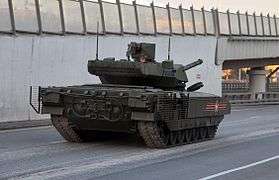 Rear and side view including the commander's hatch
Rear and side view including the commander's hatch.jpg) Close-up of the engine exhaust ports on the right side
Close-up of the engine exhaust ports on the right side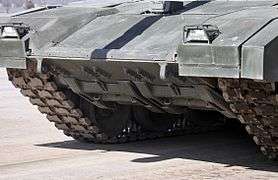 Close-up of the front, with the entrenching blade/mine countermeasures visible[76]
Close-up of the front, with the entrenching blade/mine countermeasures visible[76]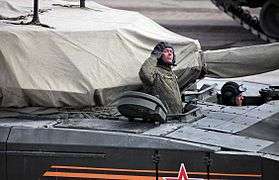 The driver has a reclining seat and a set of viewing periscopes behind his hatch for buttoned-down driving[76]
The driver has a reclining seat and a set of viewing periscopes behind his hatch for buttoned-down driving[76]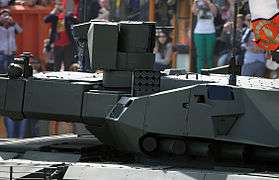 Close-up of the turret with its sensor and machine gun platform
Close-up of the turret with its sensor and machine gun platform
See also
References
- "Die Presse: российская "Армата" знаменует революцию в танкостроении". РИА Новости. Archived from the original on 2015-05-18. Retrieved 2015-05-17.
- "Танк Т-14 "Армата" или Т-99 "Приоритет"" [Tank T-14 "Armata" or T-99 "priority"] (in Russian). vpk.name. Archived from the original on 10 May 2015. Retrieved 6 May 2015.
- "Названа цена танка "Армата"". Popmech.ru. Archived from the original on 2015-09-25. Retrieved 2015-09-26.
- "Названа цена "Арматы"". rg.ru. Archived from the original on 2015-09-27. Retrieved 2015-09-26.
- "Russian Defense Ministry to get 100 Armata tanks Military & Defense August 24, 2017 The tanks are expected to be delivered before 2020". Archived from the original on 20 June 2018. Retrieved 19 June 2018.
- "The first 100 tanks "Armata" will be supplied to troops in 2017-2018 Подробнее на ТАСС". Archived from the original on 20 June 2018. Retrieved 19 June 2018.
- "Новейшие танки Т-14 "Армата" начали поступать в российскую армию 21 августа 2018". Archived from the original on 2018-10-21. Retrieved 2019-01-08.
- "Минобороны закупило 132 боевые машины Т-14 и Т-15". РИА Новости (in Russian). Archived from the original on 2018-08-22. Retrieved 2018-08-22.
- https://www.popularmechanics.com/military/a26326951/russia-to-receive-first-new-armata-tanks-in-2019/
- Вес танка и БМП на платформе «Армата» рассекретили на «Армии-2019» 2019-06-28
- "T-14 Armata main battle tank". Army Recognition. 9 August 2012. Archived from the original on 16 July 2017. Retrieved 17 July 2017.
- "Russia Created New Steel Armor for Armored Vehicles". Siberian Insider. 3 July 2014. Archived from the original on 8 May 2015. Retrieved 22 February 2015.
- Bender, Jeremy (31 May 2015). "These are the plans for Russia's new third-generation tank". Business Insider Australia. Archived from the original on 19 January 2019. Retrieved 18 January 2019.
- Administrator. "T-14 Armata Russian main battle tank technical data sheet specifications information description pictures - Russia Russian army tank heavy armoured vehicles U - Russia Russian army military equipment vehicles UK". www.armyrecognition.com. Archived from the original on 7 April 2018. Retrieved 9 April 2018.
- "БМП "Армата" сможет уничтожить вертолеты и беспилотники". Archived from the original on 2015-05-18. Retrieved 2015-05-13.
- "Россия уже начала серийное производство смертоносного танка Т-14 "Армата"". versia.ru (in Russian). 2016-05-05. Archived from the original on 2018-03-31. Retrieved 2018-03-30.
- Majumdar, Dave (2016-03-13). "Surprise: Russia's Lethal T-14 Armata Tank Is in Production". The National Interest. Archived from the original on 2018-03-30. Retrieved 2018-03-30.
- "T-14 (Object 149) Armata Main Battle Tank (MBT)". GlobalSecurity.org. n.d. Archived from the original on August 21, 2016. Retrieved September 14, 2016.
- Lockie, Alex (15 March 2016). "Russia claims its deadly T-14 Armata tank is in full production". Australian Business Insider. Sydney, Australia. Archived from the original on 27 August 2016. Retrieved 2 September 2016.CS1 maint: ref=harv (link)
- Diplomat, Franz-Stefan Gady, The. "Russia's Military to Receive 100 New T-14 Armata Battle Tanks". The Diplomat. Archived from the original on 2018-01-14. Retrieved 2018-03-30.
- Diplomat, Franz-Stefan Gady, The. "Russia Will Not Mass-Produce T-14 Armata Main Battle Tank". The Diplomat. Archived from the original on 2018-10-03. Retrieved 2019-04-07.
- "Russia: Two battalions of T-14 Armata MBT tanks will enter in service". Army Recognition: Global Defense & Security News. February 2018. Archived from the original on 23 October 2018. Retrieved 18 January 2019.
- "Первые "Арматы" получат таманцы". Izvestia. 2017-05-12. Archived from the original on 2017-05-12. Retrieved 2017-05-12.
- Mizokami, Kyle (2019-02-13). "Russia to Receive First New 'Armata' Tanks in 2019". Popular Mechanics. Archived from the original on 2019-03-08. Retrieved 2019-03-11.
- "Russia's New Tank Breaks Down During Parade Rehearsal". 7 May 2015. Archived from the original on 14 September 2016. Retrieved 23 October 2016.
- Press, Associated (7 May 2015). "State-of-the-art Russian tank breaks down at Victory Day rehearsal". Archived from the original on 12 December 2018. Retrieved 23 October 2016.
- "Парад Победы" [Victory Parade]. parad2019.mil.ru. Archived from the original on 2019-05-05. Retrieved 2019-05-05.
- "Минобороны заключило первый контракт на поставку свыше 100 танков "Армата"". РИА Новости (in Russian). 2016-09-06. Archived from the original on 2018-03-06. Retrieved 2018-03-05.
- "Путин не ставит на "Армату"". иноСМИ (in Russian). 2018-08-03. Archived from the original on 2018-08-11. Retrieved 2018-08-10.
- Kravchenko, Stepan (2018-07-30). "Tank Putin Praised May Be Too Expensive for Russia's Military". www.bloomberg.com. Archived from the original on 2018-10-30. Retrieved 2019-03-11.
- "Zamówienia na rosyjskie pojazdy Armata" [Orders for Russian Armata Vehicles]. defence24.pl. 2018-08-26. Archived from the original on 2018-09-01. Retrieved 2019-03-11.
- "Sinking the Armata?". OE Watch. Foreign Military Studies Office. October 2019. p. 3., accessed January 2020.
- ""Армату" ждет долгая дорога" ["Armata" anticipates a long road]. Voi͡enno-Promyshlennyĭ Kuri͡er (vpk-news.ru). 2019-08-12. Retrieved 2020-03-22.
- Gady, Franz-Stefan (2019-11-20). "Russia's Military to Receive First Batch of 12 T-14 Main Battle Tanks in Coming Weeks". thediplomat.com. Retrieved 2019-12-10.
- "New Armata tank to enter Russian military service this year: report". AMN - Al-Masdar News. 2020-02-03. Retrieved 2020-02-03.
- Gady, Franz-Stefan (2020-02-04). "Russian Tank Maker to Begin Deliveries of Armata Platforms in 2020". thediplomat.com. Retrieved 2020-03-22.
- "Все по-новой: в России забраковали двигатель для "Арматы"". Утро.ру (in Russian). 2020-02-04. Retrieved 2020-02-14.
- "Russia launches production of latest Armata tanks". TASS. 2020-08-03. Retrieved 2020-08-09.
- ""Армата" против "Леопарда": новый русский танк превзойдет все мировые аналоги". Archived from the original on 2015-05-18. Retrieved 2015-05-14.
- "Russia is installing toilets in the wildly expensive NATO killer T-14 supertanks it can't afford". 7 March 2019. Archived from the original on 23 March 2019. Retrieved 23 March 2019.
- Бойко, Александр (19 December 2014). "Танковые войска России переcаживаются на "Арматы"". Komsomolskaya Pravda (in Russian). Archived from the original on 25 February 2015. Retrieved 6 May 2015.
- Ukraine War Awareness. "NEW second unique footage of T-14 Armata Tank Firing UralVagonZavod 2016". YoutTube. Youtube. Archived from the original on April 6, 2017. Retrieved March 1, 2017.
- "Take Cover! Russian Armata Tank Gets New High-Tech Ammo Type - Sputnik International". Archived from the original on 2018-06-14.
- International, Sputnik (26 April 2015). "Russian T-14 Armata: Most Powerful Tank in the World in Details". Sputnik International. Archived from the original on 20 April 2017. Retrieved 19 April 2017.
- "Пушка Т14 пробивает до 2 метров гомогенной стали - youinf.ru - информационно-познавательный журнал YouMag". Archived from the original on 9 October 2016. Retrieved 23 October 2016.
- Птичкин, Сергей (5 May 2015). "Ракеты собьют на подлете". Rossiyskaya Gazeta (in Russian). Archived from the original on 7 May 2015. Retrieved 13 May 2015.
- "Take Cover! Russian Armata Tank Gets New High-Tech Ammo Type". Sputnik. Archived from the original on 9 September 2016. Retrieved 23 October 2016.
- "Создан новый боеприпас для танка "Армата" - Еженедельник "Военно-промышленный курьер"". Archived from the original on 11 October 2016. Retrieved 23 October 2016.
- Щеголев, Илья (23 January 2015). ""Армата" против "Леопарда 2" и "Абрамса"". Rossiyskaya Gazeta (in Russian). Archived from the original on 28 June 2015. Retrieved 13 May 2015.
- Mizokami, Kyle (21 June 2017). "Russia's T-14 Tank Can Outshoot America's by Miles". Popular Mechanics. Archived from the original on 16 November 2018. Retrieved 25 September 2018.
- "Третье поколение для "Арматы": как испытывают комплекс "Сокол-В"" (in Russian). Retrieved 21 November 2019.
- https://special-ops.org/11936/russias-armata-t-14-tank-and-10-facts-you-need-to-know-about/
- "Антикризисная модель "Арматы"". svpressa.ru (in Russian). 10 March 2015. Archived from the original on 4 May 2015. Retrieved 6 May 2015.
- "Танк "Армата" усилят пушкой калибром 152 мм". EADaily. Archived from the original on 2015-05-18. Retrieved 2015-05-14.
- "Рогозин: танк "Армата" оборудуют новой пушкой с мощным зарядом". РИА Новости. Archived from the original on 2015-05-16. Retrieved 2015-05-14.
- Егор Созаев-Гурьев. ""Армату" сделают мощнее". Известия. Archived from the original on 2015-05-15. Retrieved 2015-05-14.
- "История создания перспективного танка. "Русский "Тигр" Т-95"" (in Russian). 11 August 2013. Archived from the original on 27 June 2015. Retrieved 18 May 2015.
- "Т-95 / Объект 195" (in Russian). 1 May 2011. Archived from the original on 31 May 2015. Retrieved 18 May 2015.
- "152-мм пушка для "Арматы"" (in Russian). Archived from the original on 27 June 2015. Retrieved 18 May 2015.
- Russia's New Tanks Are Pretty 'Stale' Archived 2015-06-10 at the Wayback Machine – Offiziere.ch, 10 June 2015
- "Танк Т-14 "Армата". Инфографика". Archived from the original on 2015-05-12. Retrieved 2015-05-15.
- Paul Richard Huard. "The T-14 Is a New Russian Tank —And a Whole Lot More — War Is Boring". Medium. Archived from the original on 2015-05-18. Retrieved 2015-05-15.
- "Дизельный двигатель 12Н360". ЧТЗ-УРАЛТРАК (in Russian). Archived from the original on 2015-08-23. Retrieved 2015-05-05.
- АО ИД «Комсомольская правда». ""Армата" - то что надо". АО ИД «Комсомольская правда». Archived from the original on 2015-03-19. Retrieved 2015-05-14.
- "Танк Т-14 "Армата": технические характеристики". 6 September 2016. Archived from the original on 29 September 2017. Retrieved 9 April 2018.
- Литовкин, Дмитрий (9 May 2015). "Цена танка "Армата" вызвала споры" (in Russian). vestifinance.ru. Archived from the original on 17 June 2015. Retrieved 9 June 2015.
- "Танк Т-14 "Армата" или Т-99 "Приоритет"". Archived from the original on 2015-05-10. Retrieved 2015-05-06.
- "Трансмиссия для "Арматы"". Gur Khan Attacks (in Russian). 2 May 2015. Archived from the original on 8 May 2015. Retrieved 15 May 2015.
- "Следующий – Т-14". Vzglyad (in Russian). 26 September 2013. Archived from the original on 16 May 2015. Retrieved 17 May 2015.
- "Активная подвеска танка "Армата"". Gur Khan Attacks (in Russian). 12 May 2015. Archived from the original on 12 October 2015. Retrieved 17 May 2015.
- "ТАСС: Армия и ОПК - Серийный выпуск керамики для брони "Арматы" начался в Новосибирске". ТАСС. Archived from the original on 2015-07-08. Retrieved 2015-07-09.
- Sputnik. "Can't Touch This! Russian Armata Tanks to Get New Active Protection System". sputniknews.com. Archived from the original on 17 August 2018. Retrieved 9 April 2018.
- "Archived copy" (PDF). Archived from the original (PDF) on 2015-05-18. Retrieved 2015-06-04.CS1 maint: archived copy as title (link)
- The TOW Missile: The One Weapon That Could Make Russia's Super Armata Tank Obsolete? Archived 2017-05-21 at the Wayback Machine - Nationalinterest.org, 30 March 2017
- Is Now the Time to Arm US Tanks with Israeli Anti-Missile Tech? Archived 2017-09-30 at the Wayback Machine - Military.com, 20 May 2017
- "New Russian Armor; First analysis: Armata". defense-update.com. 9 May 2015. Archived from the original on 18 May 2015. Retrieved 16 May 2015.
- The Game Changing Feature in Russia's T-14 Armata That Might Make NATO Tanks Obsolete Archived 2016-09-29 at the Wayback Machine, National Interest, 28 September 2016
- ""Армата" получила защиту от уранового оружия". 22 September 2016. Archived from the original on 3 May 2018. Retrieved 9 April 2018.
- "КОМПЛЕКС ЗАЩИТЫ ВЕРХНЕЙ ПОЛУСФЕРЫ". НИИ Стали (in Russian). Archived from the original on 2015-05-18. Retrieved 2015-05-16.
- "Что представляет из себя танк Т-14 "Армата"?". Archived from the original on 2015-12-22. Retrieved 2015-05-16.
- ""Армата" расстреляет снаряды противника из пулемета". Известия (in Russian). Archived from the original on 2015-05-18. Retrieved 2015-05-15.
- "Archived copy". Archived from the original on 2018-12-17. Retrieved 2018-12-17.CS1 maint: archived copy as title (link)
- Franz-Stefan Gady, "Is 'Russia's Deadliest Tank' Really Invisible to the Enemy?" Archived 2015-08-15 at the Wayback Machine, The Diplomat, 13 August 2015
- Шпаковский, Вячеслав (14 May 2015). "В чем главные достоинства новейшего российского танка Т-14 "Армата"" (in Russian). Pravda. Retrieved 9 May 2020.
- "САУ "Коалиция-СВ" установила рекорд дальности стрельбы". Archived from the original on 2015-05-18. Retrieved 2015-05-17.
- "На танки "Армата" установят радары с АФАР" (in Russian). army-news.ru. 23 January 2014. Archived from the original on 11 May 2015. Retrieved 13 May 2015.
- "Russia's armour revolution". Jane's 360. Archived from the original on 2015-05-17. Retrieved 2015-05-18.
- Franz-Stefan Gady, "Is Russia's 'Deadliest Tank' Using Western Technology?" Archived 2015-06-16 at the Wayback Machine, The Diplomat, 6 June 2015
- "Unmanned Robotic Armata Tank to Be Developed in 2018 - Russian Defense Ministry - Sputnik International". Archived from the original on 2018-10-23.
- Archived 2015-05-26 at the Wayback Machine – RIA Novosti.com, 26 May 2015
- Archived 2015-05-27 at the Wayback Machine – Sputniknews.com, 26 May 2015
- Archived 2015-07-28 at the Wayback Machine – Sputniknews.com, 4 June 2015
- Franz-Stefan Gady, "Can This Chinese Tank Beat Russia's T-14 Armata?" Archived 2015-06-13 at the Wayback Machine, The Diplomat, 9 June 2015
- Majumdar, Dave. "Surprise: Russia's Lethal T-14 Armata Tank Is in Production". Archived from the original on 22 October 2016. Retrieved 23 October 2016.
- "UK military intelligence issues warning over Russian supertank threat". The Telegraph. 6 November 2016. Archived from the original on 11 November 2016. Retrieved 13 November 2016.
Without hyperbole, Armata represents the most revolutionary step change in tank design in the last half century. ..revolutionary turret design that makes crew less vulnerable under fire. The tank is also reckoned to be lighter, faster and lower in profile than Western rivals.
- "Putin's Got a Cool New Tank: How Many Can He Afford?". The Fiscal Times. 7 May 2015. Archived from the original on 31 December 2016. Retrieved 13 November 2016.
- Majumdar, Dave (7 November 2016). "Russia's Armata T-14 Tank Could Be Super Dangerous on the Battlefield (But There Is One Simple Problem)". The National Interest. Archived from the original on 10 November 2016. Retrieved 13 November 2016.
- Administrator. "Rheinmetall future MBT main battle tank MGCS Main Ground Combat System with 130mm cannon 11802161 | February 2016 Global Defense Security news industry | Defense Security global news industry army 2016 | Archive News year". armyrecognition.com. Archived from the original on 2016-12-07. Retrieved 2017-01-22.
External links
| Wikimedia Commons has media related to T-14 Armata. |
- New Russian Armor – First analysis: Armata: Defense Update analysis.
- Russia's armour revolution: Jane's analysis (archived version).
- Full details: Armata official government source
- The T-14 Armata from a technical point of view, by Captain Stefan Bühler, graduate engineer (University of Applied Sciences), Explosive Ordnance Disposal Officer at the NBC-KAMIR Competence Center for the Swiss Armed Forces and Commander of Tank Squadron 12/1